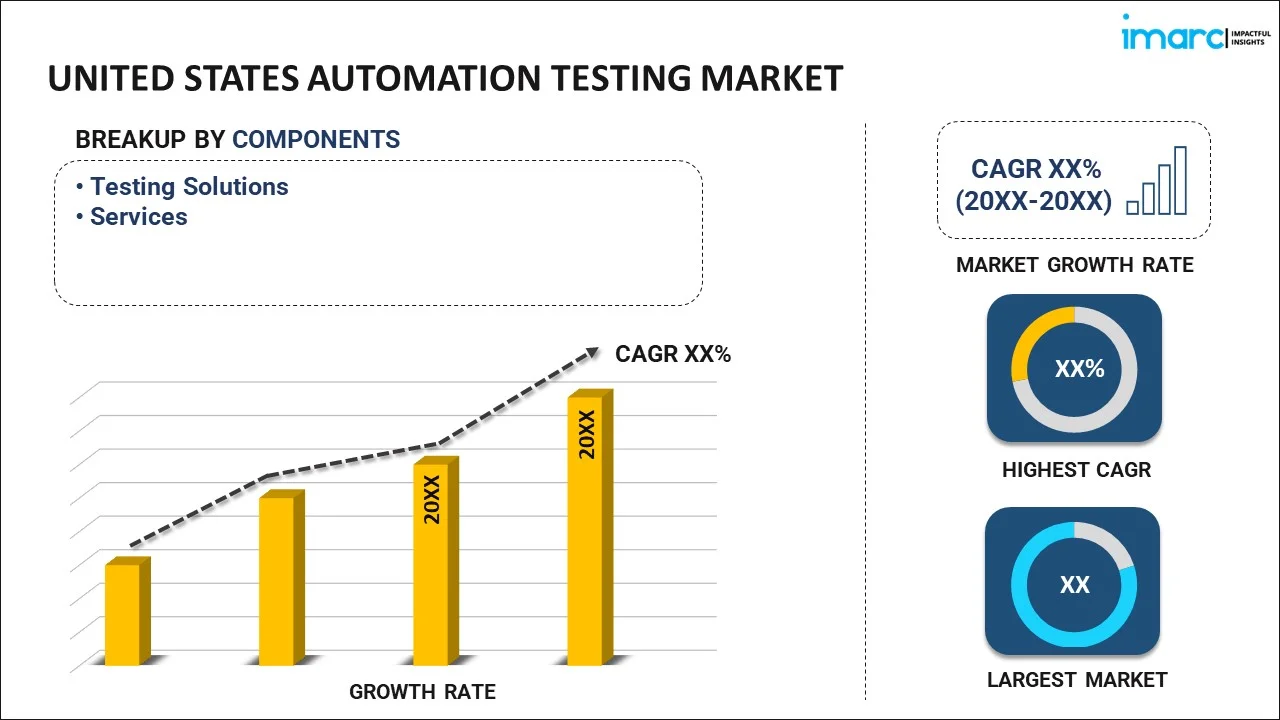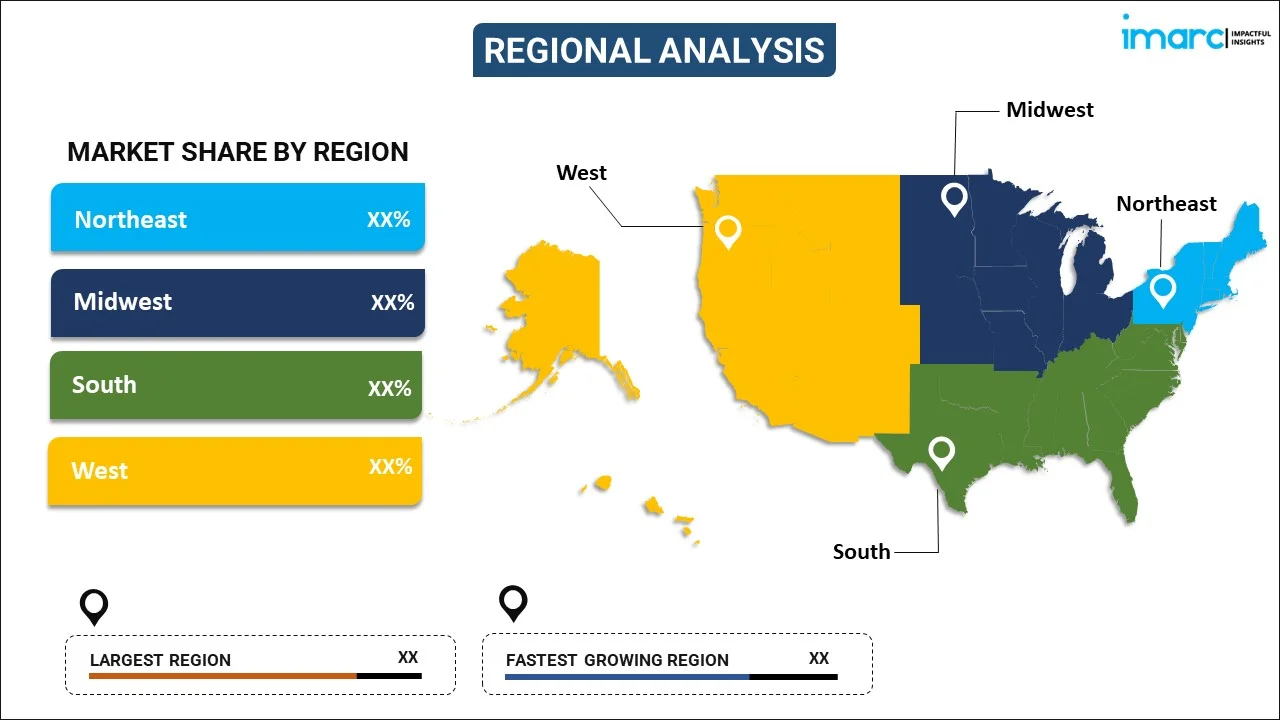
United States Automation Testing Market Report by Component (Testing Solutions, Services), Endpoint Interface (Web, Mobile, Desktop, Embedded Software), Enterprise Size (Small and Medium-Sized Enterprises, Large Enterprises), End User (IT and Telecommunication, BFSI, Healthcare, Retail, Transportation and Logistics, and Others), and Region 2024-2032
Market Overview:
United States automation testing market size is projected to exhibit a growth rate (CAGR) of 14.30% during 2024-2032. The increasing complexity of software applications, especially in areas such as web and mobile development, coupled with the rising demand for automation testing that can efficiently handle repetitive and complex test scenarios, is driving the market.
|
Report Attribute
|
Key Statistics
|
|---|---|
|
Base Year
|
2023 |
|
Forecast Years
|
2024-2032
|
|
Historical Years
|
2018-2023
|
| Market Growth Rate (2024-2032) | 14.30% |
Automation testing is a software testing technique where automated tools and scripts are used to perform tests on a software application. It aims to enhance the efficiency, effectiveness, and coverage of the testing process. Automated testing involves the creation of test scripts that can be executed repeatedly without manual intervention. These scripts simulate user interactions with the application, verifying its functionality, performance, and reliability. Automation testing is particularly beneficial for repetitive and time-consuming tasks, allowing faster and more reliable test execution. It helps identify defects early in the development cycle, reducing the overall testing time and costs. Commonly used tools for automation testing include Selenium, Appium, and JUnit. While automation testing offers numerous advantages, it is essential to balance it with manual testing to ensure comprehensive test coverage and address aspects that may be challenging for automated scripts.
United States Automation Testing Market Trends:
The automation testing market in the United States is being propelled by several key drivers, all interconnected to meet the growing demands of the software development lifecycle. Firstly, the escalating complexity of software applications necessitates robust testing mechanisms, driving the adoption of automation testing tools. Moreover, in tandem with the increasing pace of software development, organizations are pressed to enhance efficiency, reduce time-to-market, and ensure a high level of accuracy in testing processes. Consequently, this has fueled the demand for automation testing solutions that offer rapid test execution and comprehensive coverage. Furthermore, the shift towards Agile and DevOps methodologies has become a linchpin in the software development landscape, acting as a catalyst for the automation testing market. As organizations strive for continuous integration and delivery, the need for automated testing becomes imperative to maintain the agility and quality of software releases. Additionally, cost effectiveness plays a pivotal role as automation testing streamlines testing cycles, minimizes manual errors, and ultimately reduces overall testing costs. In summary, the confluence of factors such as application complexity, the need for speed, Agile methodologies, and cost considerations are interconnected drivers propelling the growth of the automation testing market in the United States.
United States Automation Testing Market Segmentation:
IMARC Group provides an analysis of the key trends in each segment of the market, along with forecasts at the country level for 2024-2032. Our report has categorized the market based on component, endpoint interface, enterprise size, and end user.
Component Insights:

- Testing Solutions
- Functional Testing
- API Testing
- Security Testing
- Compliance Testing
- Usability Testing
- Others
- Services
- Professional Services
- Managed Service
The report has provided a detailed breakup and analysis of the market based on the component. This includes testing solutions (functional testing, API testing, security testing, compliance testing, usability testing, and others) and services (professional services and managed service).
Endpoint Interface Insights:
- Web
- Mobile
- Desktop
- Embedded Software
A detailed breakup and analysis of the market based on endpoint interface have also been provided in the report. This includes web, mobile, desktop, and embedded software.
Enterprise Size Insights:
- Small and Medium-sized Enterprises
- Large Enterprises
The report has provided a detailed breakup and analysis of the market based on the enterprise size. This includes small and medium-sized enterprises and large enterprises.
End User Insights:
- IT and Telecommunication
- BFSI
- Healthcare
- Retail
- Transportation and Logistics
- Others
A detailed breakup and analysis of the market based on end user have also been provided in the report. This includes IT and telecommunication, BFSI, healthcare, retail, transportation and logistics, and others.
Regional Insights:

- Northeast
- Midwest
- South
- West
The report has also provided a comprehensive analysis of all the major regional markets, which include the Northeast, Midwest, South, and West.
Competitive Landscape:
The market research report has also provided a comprehensive analysis of the competitive landscape in the market. Competitive analysis such as market structure, key player positioning, top winning strategies, competitive dashboard, and company evaluation quadrant has been covered in the report. Also, detailed profiles of all major companies have been provided.
United States Automation Testing Market Report Coverage:
| Report Features | Details |
|---|---|
| Base Year of the Analysis | 2023 |
| Historical Period | 2018-2023 |
| Forecast Period | 2024-2032 |
| Units | US$ Million |
| Scope of the Report | Exploration of Historical and Forecast Trends, Industry Catalysts and Challenges, Segment-Wise Historical and Predictive Market Assessment:
|
| Components Covered |
|
| Endpoint Interfaces Covered | Web, Mobile, Desktop, Embedded Software |
| Enterprise Sizes Covered | Small and Medium-Sized Enterprises, Large Enterprises |
| End Users Covered | IT and Telecommunication, BFSI, Healthcare, Retail, Transportation and Logistics, Others |
| Regions Covered | Northeast, Midwest, South, West |
| Customization Scope | 10% Free Customization |
| Report Price and Purchase Option | Single User License: US$ 3699 Five User License: US$ 4699 Corporate License: US$ 5699 |
| Post-Sale Analyst Support | 10-12 Weeks |
| Delivery Format | PDF and Excel through Email (We can also provide the editable version of the report in PPT/Word format on special request) |
Key Questions Answered in This Report:
- How has the United States automation testing market performed so far and how will it perform in the coming years?
- What has been the impact of COVID-19 on the United States automation testing market?
- What is the breakup of the United States automation testing market on the basis of component?
- What is the breakup of the United States automation testing market on the basis of endpoint interface?
- What is the breakup of the United States automation testing market on the basis of enterprise size?
- What is the breakup of the United States automation testing market on the basis of end user?
- What are the various stages in the value chain of the United States automation testing market?
- What are the key driving factors and challenges in the United States automation testing?
- What is the structure of the United States automation testing market and who are the key players?
- What is the degree of competition in the United States automation testing market?
Key Benefits for Stakeholders:
- IMARC’s industry report offers a comprehensive quantitative analysis of various market segments, historical and current market trends, market forecasts, and dynamics of the United States automation testing market from 2018-2032.
- The research report provides the latest information on the market drivers, challenges, and opportunities in the United States automation testing market.
- Porter's five forces analysis assist stakeholders in assessing the impact of new entrants, competitive rivalry, supplier power, buyer power, and the threat of substitution. It helps stakeholders to analyze the level of competition within the United States automation testing industry and its attractiveness.
- A competitive landscape allows stakeholders to understand their competitive environment and provides an insight into the current positions of key players in the market.
Need more help?
- Speak to our experienced analysts for insights on the current market scenarios.
- Include additional segments and countries to customize the report as per your requirement.
- Gain an unparalleled competitive advantage in your domain by understanding how to utilize the report and positively impacting your operations and revenue.
- For further assistance, please connect with our analysts.
 Inquire Before Buying
Inquire Before Buying
 Speak to an Analyst
Speak to an Analyst
 Request Brochure
Request Brochure
 Request Customization
Request Customization




.webp)




.webp)












